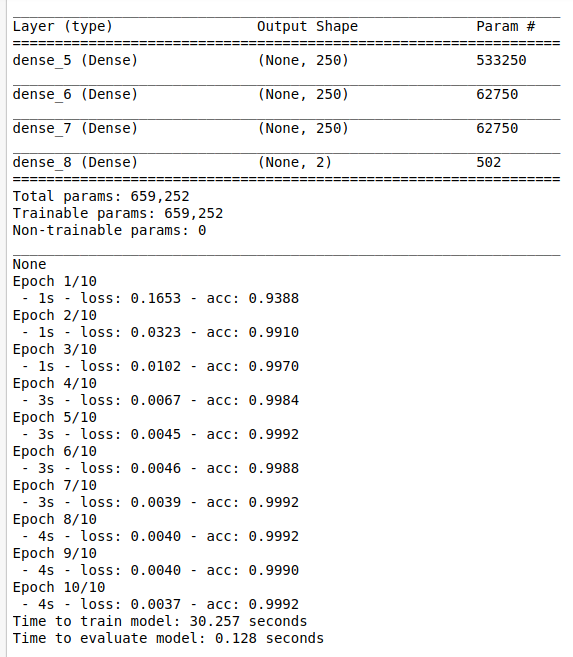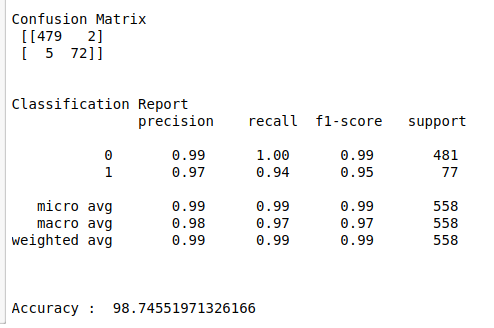To build a spam email detection system using keras with deep learning in python.
SMS Spam collection data set.
Classification report, confusion matrix and accuracy_score
Import necessary libraries.
Load the data set.
Do pre process the text data.
Fix independent and dependent variables.
Encode the target variables.
Build the model.
Fit the train data.
Test the model using test data.
Print the results.
#import necessary libraries
import warnings
warnings.filterwarnings(“ignore”)
import pandas as pd
import numpy as np
import re
import time
from sklearn.preprocessing import LabelEncoder
from sklearn.feature_extraction.text import TfidfVectorizer
from sklearn.model_selection import train_test_split
from keras.utils import np_utils
from keras.models import Sequential
from keras.layers import Dense
from sklearn.metrics import classification_report, confusion_matrix, accuracy_score
names = [‘class’,’text’]
data = pd.read_csv(“…/SMSSpamCollection.csv”,sep=”\t”,names = names)
#make as a data frame
df = pd.DataFrame(data)
#Checking missing values
print(“Checking missing values\n”)
print(df.isnull().sum())
#lebel encoding
from sklearn.preprocessing import LabelEncoder
lb_make = LabelEncoder()
df[“target”] = lb_make.fit_transform(df[“class”])
df[[“class”, “target”]].head(11)
#variable selection
X = df[‘text’]
y = df[‘target’]
#change text lower cases and removal of white spaces
lower_text = []
for i in range(0,len(X)):
s = str(X[i])
s1 = s.strip()
lower_text.append(s1.lower())
#print(“After converting text to lower case\n\n”,lower_text)
#Remove punctuation
punc_text = []
for i in range(0,len(lower_text)):
s2 = (lower_text[i])
s3 = re.sub(r'[^\w\s2]’,”,s2)
punc_text.append(s3)
#print(“After removed punctuation\n\n”,punc_text)
#Word vectorization
#Initialize the TF-IDF vectorizer
tfidf = TfidfVectorizer(sublinear_tf=True, min_df=5,max_df = 0.7,norm=’l2′, encoding=’latin-1′, ngram_range=(1, 2),
stop_words=’english’)
#transform independent variable using TF-IDF vectorizer
print(“\n”)
X_tfidf = tfidf.fit_transform(punc_text)
print(“After vectorized text data\n\n”,X_tfidf)
#Split the data into train and testing
X_train, X_test, Y_train, Y_test = train_test_split(X_tfidf, y, test_size=0.1, random_state=0)
#Print training data
print(“\n”)
print(“Training data\n\n”,X_train,”\n”,Y_train)
print(“\n\n”)
#Print testing data
print(“Testing data\n\n”,X_test)
print(“\n\n”)
#make dependent variable categorical
Y_train = np_utils.to_categorical(Y_train,num_classes=2)
Y_test = np_utils.to_categorical(Y_test,num_classes=2)
batch_size = 20
#shape of input
n_cols_2 = X_train.shape[1]
#create deep neural networks
model_2 = Sequential()
#add layers to model
model_2.add(Dense(250, activation=’relu’, input_shape=(n_cols_2,)))
model_2.add(Dense(250, activation=’relu’))
model_2.add(Dense(250, activation=’relu’))
model_2.add(Dense(2, activation=’softmax’))
print(model_2.summary())
#Compile the model
model_2.compile(optimizer=’adam’, loss=’binary_crossentropy’, metrics=[‘accuracy’])
#Here we train the Network.
start_time = time.time()
model_2.fit(X_train, Y_train, batch_size = batch_size, epochs = 10, verbose = 2)
end_time = time.time()
elapsed_time = end_time – start_time
print(“Time to train model: %.3f seconds” % elapsed_time)
#Evaluate the network
start_time = time.time()
score,acc = model_2.evaluate(X_test,Y_test,verbose = 2,batch_size = batch_size)
end_time = time.time()
elapsed_time = end_time – start_time
print(“Time to evaluate model: %.3f seconds” % elapsed_time)
print(“\n”)
#Predict the test results
prediction = model_2.predict(X_test)
length = len(prediction)
y_label = np.argmax(Y_test,axis=1)
predict_label = np.argmax(prediction,axis=1)
#classification report
print(“Confusion Matrix\n”,confusion_matrix(y_label,predict_label))
print(“\n”)
print(“Classification Report\n”,classification_report(y_label,predict_label))
print(“\n”)
print(“Accuracy : “,accuracy_score(y_label,predict_label)*100)

